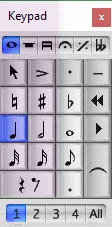Sibelius
Created: 2015-12-18 23:22:33 -0800 Modified: 2023-12-03 11:07:20 -0800
Sibelius First
Section titled “Sibelius First”- To export to a PDF on macOS, go to File → Print → “Use OS Dialog” (a button at the bottom) → Click “PDF” at the bottom left.
Helpful shortcuts (reference (some of these seem wrong though))
Section titled “Helpful shortcuts (reference (some of these seem wrong though))”- Play from beginning: escape escape P (two escapes to make sure you’ve cleared your focus)
- Ctrl+alt+B: show piano keyboard
- [Shift]+NumpadPlus: go to first/next keypad pages to get things like double sharps, grace notes, etc.
Less helpful
Section titled “Less helpful”- K: key signature
- L: lines menu
- Q: clefs
- R: given a selection, this will copy and paste it into the next available space. This is helpful for laying down some chords and having them repeat
- T: time signature
- Ctrl+B: add bar to end of piece
- Ctrl+shift+B: add bar after cursor
- Ctrl+shift+[left|right]: expand selection left or right by a whole measure (note: ctrl+Z will undo JUST the selection aspect if you go too far)
- X: toggle the stem of the note from above/below
- Ctrl+K: create chord-symbol text (then just use space/tab to navigate). This is really helpful for writing in chords as per this video (linked to timestamp)
- Working with voices
- Alt+[1-4]: change voice of selected note
- Ctrl+alt+shift+[1-4]: filter so that you’re only selecting that particular voice
Helpful tips
Section titled “Helpful tips”Changing the page on the keypad
Section titled “Changing the page on the keypad”
The ”«” and ”>” buttons move between the different tabs of this page. These correspond to NumpadPlus and shift+NumpadPlus
Creating four-part harmonies
Section titled “Creating four-part harmonies”Seems like you should use voice 1 for the soprano and tenor and voice 2 for the alto and bass rather than using all four of Sibelius’s voices. You can always change it later anyway by selecting an entire staff, then using ctrl+alt+shift+2 to filter to the second voice, then alt+4 to change it to the fourth voice if you want, but I found that it’s way too hard to reliably input notes using all four voices.
A good way to fill in “blank” voices is to switch to a voice, enter note input, and just hold numpad-0 to fill in rests everywhere.
To add figured-bass easily, click a note, then choose text —> harmony —> figured bass, then press space to move to the next note.
As for the music-theory part, this seems like a good document.
Setting tempo without a numpad
Section titled “Setting tempo without a numpad”Text —> Tempo —> Click a section of the music to set the tempo for —> Right-click (basically anywhere in the canvas) to get the menu of what’s available to you
Add an anacrusis (pick-up beat) (reference)
Section titled “Add an anacrusis (pick-up beat) (reference)”Notations —> Time Signature —> More Options —> Start with bar of length
Fixing accidentals so that they match the scale
Section titled “Fixing accidentals so that they match the scale”- Select all of the music you want to change
- Go to Home —> Plug-ins —> Transform Scale
- You can customize things here. I just used the same current scale as the new scale because I’d screwed up the old scale. I’d been writing the music in C Major and then switched to F# Minor once I realized what key it was in, but that didn’t fix all the flats that I had in the music. So I chose F# —> F# and it fixed most of it. I probably could’ve customized things more to make it even better.
Troubleshooting
Section titled “Troubleshooting”12/18/2015
If you recorded something “live” and editing the notes isn’t getting it to play back what’s written (as opposed to what was recorded), then go to the Play menu and uncheck “live playback”.